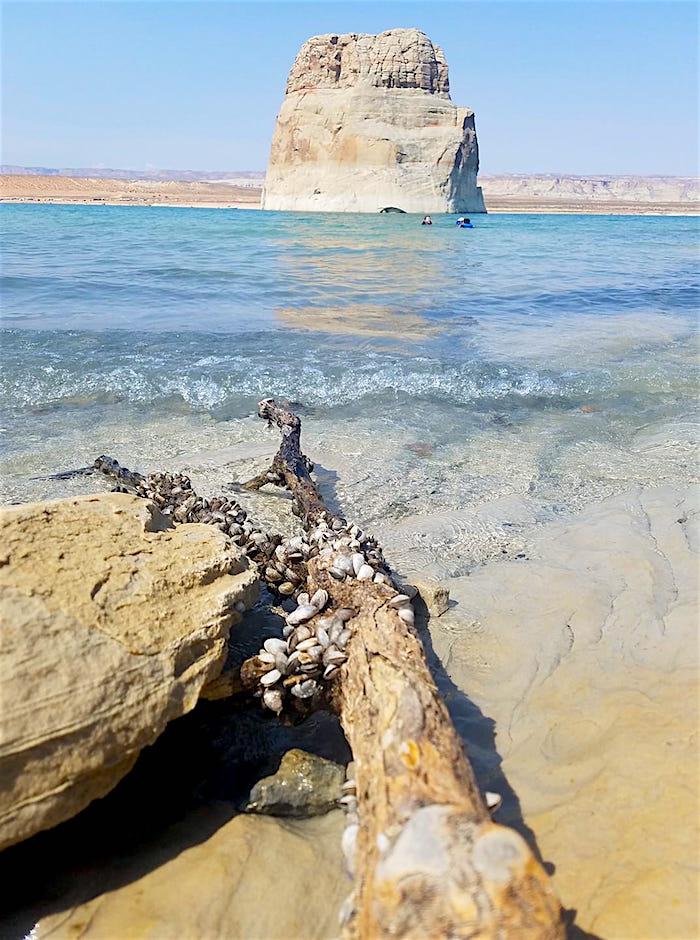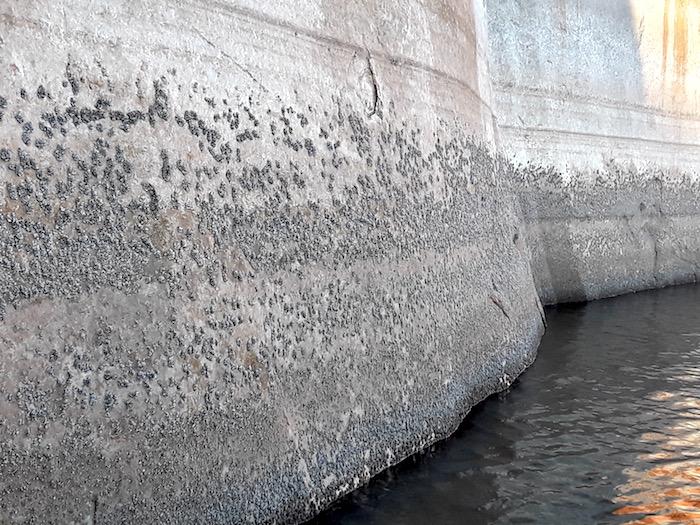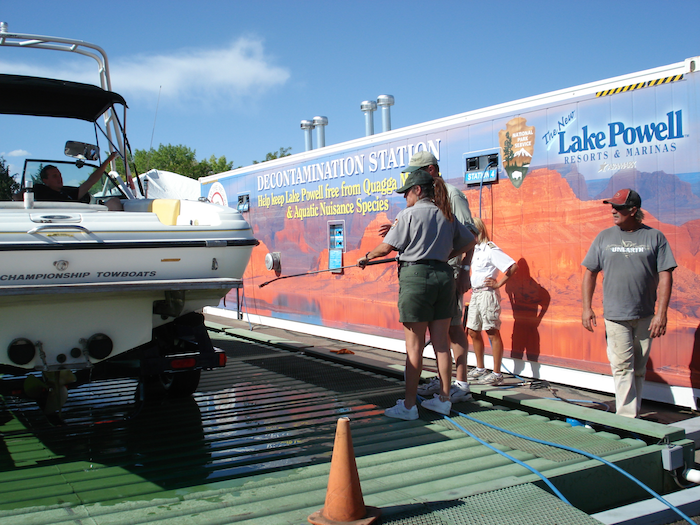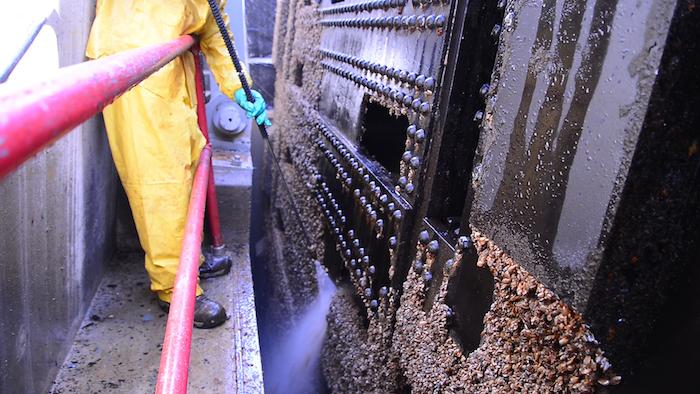
Quagga mussels on the shore with Lone Rock in the background at Glen Canyon National Recreation Area/David Rankin via NPS
Though only about the size of a dime, nonnative shellfish from the other side of the world have infested Lake Powell at Glen Canyon National Recreation Area, where they are impairing beaches, encrusting some boats, and threatening the hydropower operations of the Glen Canyon dam. They also pose a threat to one of the National Park System's top economic drivers.
"They ruin a lot of recreation areas that people typically like to visit just because they’re no longer really usable," explained Nathan Owens, the aquatic invasive species coordinator for Utah's Division of Wildlife Resources. "That’s kind of what we’re starting to see in a few areas at Lake Powell for the first time. I’ve been told by boaters, they’ve tried to pull up to land but they didn’t want to walk out because it was covered in mussels and they didn’t want to get cut up. So they just ended up going somewhere else."
For now there are lots of other places to go at Lake Powell, which has a surface area of about 252 square miles. But as the runoff that fills the reservoir falls due to diversions and drought, which has gripped the Colorado River watershed since 2000, the reservoir level falls, exposing more beaches covered with quagga mussels.
"Because of the higher lake level last year, the quaggas attached higher up on the rock walls," said Mary Plumb, public information officer for the NRA. "And this year we have a lot lower lake level, because of the lower snowpack, and so the quaggas that attached themselves higher up are now a lot more visible.
”There hasn’t been an increase in population," she added, "it’s just more visible.”
The infestation also, at this point, appears to be irreversible, as the mussels are incredibly prolific and have no natural predator that can dent their numbers.
“The mussels reproduce at Lake Powell on a monthly basis, and every time they reproduce (each mussel) can produce upwards of 1 million eggs," said Owens. "They are pretty prolific breeders.That’s one of the reasons why, once you find a population, unless you’re incredibly lucky and have absolutely perfect conditions, there’s really nothing you can do.”
The state official said Lake Powell's relatively warm waters enable the mussels to reproduce so rapidly.
“They reproduce anywhere where the water temperature is between 50 degrees and 75 degrees or 80 degress, somewhere in that range, and Lake Powell stays within that temperature a large part of the year," said Owens. "It’s kind of like the perfect environment if you’re a mussel factory. They can just keep churning themselves out.”

Countless quagga mussels cling to a wall at Lake Powell in Glen Canyon NRA/Utah DWR
Though native to the Caspian, Black, and Azov seas in eastern Europe, the mussels are thought to have hitchhiked to North American in the ballast water of ocean-going ships. Arriving in the Great Lakes around 1986, the shellfish have continually expanded their habitat in the United States, first moving through the Great Lakes and Mississippi River Basin states before heading in all compass directions by catching rides on boats and trailers.
They turned up in Lake Mead National Recreation Area in 2007, and were spotted six years later in Glen Canyon National Recreation Area, which ranked ninth among the 417 units of the National Park System in terms of economic impact to local communities, with $361 million last year.
“Lake Mead got them on their own. They were the first place out in the West to have them," Owens said. "It’s believed that probably a boat from Lake Mead transported them up to Lake Powell. I believe it’s the same genetically distinct population.”
While Lake Powell officials initially expressed some optimism that they could wipe out the 14 new arrivals when they were spotted at the Wahweap Marina in 2013, in hindsight they never had a chance. While the NRA launched a mussel prevention program in 2000, so many boaters head to Lake Powell that its monitoring program was overrun.
Today, with declining water levels, not only are the mussels more visible, clinging to rocks, beaches, downed trees, and canyon walls, but those that are now beached quickly die, and their shells get blown into the water. There they float not just by themselves, but very possibly with tens of millions, or more, of veligers, the larval stage of the mussels, that are carried in the water column.
No longer is the focus on keeping quagga mussels out of Lake Powell. The task is keeping them in the reservoir so they don't infest other waters.
“It’s pretty awful right now. We’re seeing boats with mussels pretty regularly at this point," Owens said of inspection points at Lake Powell. "We’ve gotten to the point that we have to suspect that every boat retrieved out of Lake Powell probably has mussels somewhere. Our staff is kind of overwhelmed at this point, scrambling around, trying to do everything we can, but we’re kind of at capacity. Our inspections and our decontaminations are way up this year, yet we’re still encountering boats with mussels around the state."

A quagga mussel decontamination station at Glen Canyon NRA/NPS
National Park Service personnel and crews from the state of Utah operate the decontamination stations at Lake Powell's boat ramps, inspecting boats when their owners are ready to end their vacations and decontaminating those that either visibily, or possibly, are carrying the mussels. It's a timely process, one that can create waits of four hours or so for vacationeers anxious to head for home. Over the course of a year, as many as 120,000 boats might have been stopped on their way off the reservoir, and perhaps a third inspected, said Colleen Allen, the NRA's aquatic invasive species coordinator.
"It’s a huge screening process and a large outreach effort that’s applied at all of the marinas, to have conversations with these boaters to address them as they’re moving about," said Allen. "Not everybody requires a decontamination to transport away from the lake. There’s a huge responsibility upon the boater for the 'clean, drain, dry' initiative. Essentially, you clean your boat, pull all your plugs, drain all your water systems, and then let your boat dry for a period of time.
"That dry time varies depending on where you’re headed home to. Montana is longer than it would be to Arizona," she pointed out. "That has to do with humidity, heat and such. Here, collectively, we address boats through our screening process. We identify those boats that cannot meet the dry time where they’re headed home to. Those boats are given a decontamination.”
Owens, noting that it can take anywhere from 25 minutes to an hour-and-a-half to decontaminate a boat, said it'd be impractical to try to put every boat and personal watercraft through the process.
"So many boats need to be decontaminated," he said. "We’re now overwhelmed with those requests. We’re trying to figure out ways to deal with that; disperse the workload out to different locations, offer decontamination services, or even maybe potentially implement new technologies, like dip tanks to allow for quicker decontaminations on a variety of differrnt boats.
“The hardest thing is that there are so many different kinds of boats out there, and each one is so unique in the way their systems are set up that there’s no easy way to quickly determine what ports feed what systems and what areas on a boat need to be decontimated," Owens went on. "It’s sort of once we get to the boat our technicians have to decide what areas need to be decontaminated and how these systems work. ... A typical wake board boat may have four different or five different ballast tanks that each need to be decontaminated. Each one of those ballast tanks may take ten or 15 minutes. So it’s a challenge.”
The decontamination in the tanks is accomplished by pumping into the tanks water heated to 120 degrees Fahrenheit, he said, while the outer hulls are washed down with water heated to 140 degrees Fahrenheit.
"Many boats look exactly the same but have different internal water systems, and different types of engines," Allen said. "(Boaters) use their boats differently. Some folks use their anchor, where they potentially could pick up an aquatic hitchhiker on their anchor. Or you have your ballast boats that take on large amounts of water that then can transport the veliger and or mussels away.”
There is ongoing research into possibly using gene manipulation to beat back the populations, and discussions with boat and engine manufacturers in search of easier ways to decontaminate vessels, but there don't appear to be any natural predators that would impact the quagga populations.
"There are a few fish species that eat them, like the Redear sunfish, which you can find in Lake Havasu. They eat them," said Owens. "Some diving duck species eat them, but nothing eats them in quantities enough to actually be able to control them. There’s a discssuion that maybe we should just introduce Redear sunfish into Lake Powell and they’ll eat all the mussels, and that’s actually completely implausible They would never eat enough mussels to have any sort of observable impact on the population.”

Cleaning quagga mussels from penstock gates at Glen Canyon Powerplant is a regular routine/BuRec CWatt
The infestation also is a concern for the U.S. Bureau of Reclamation, which operates the hydrogenerating station in the Glen Canyon Dam.
"Quagga mussels have covered many of the parts and pipes of the dam where the water flow is slow enough for drifting quagga mussels to grab onto objects and hang on," said Chris Watt, a public affairs specialist for the bureau's Upper Colorado River Region. "While the presence of quagga mussels over the last several years has increased the time and effort we spend on routine cleaning and maintenance of the pipes and gates of the dam, the mussel colonies have not yet had any affect on our day-to-day dam operations.
"However, we know the experts and professionals at other dam facilities in the United States are currently dealing with challenges created by an increase in quagga mussels, so we are watching the situation at Glen Canyon Dam closely while learning and applying the lessons learned from other facilities," he added.
While both Lake Powell and Lake Mead are heavily infested with the mussels, Jackson Lake in Grand Teton National Park has not seen any, nor has Lake McDonald in Glacier National Park, according to officials at those parks. While nonnative New Zealand Mud Snails have reached Yellowstone National Park, there have not been confirmed reports of quagga or zebra mussels there, according to the park's website. Curecanti National Recreation Area in Colorado also has not reported them and has an active prevention program in place.
While Lake Powell drains back to the Colorado River that runs through Grand Canyon National Park, problems with the mussels have not been reported there, most likely due to the fast moving, turbid water.



Comments
Edward Abbey might argue that Lake Powell itself is "non-native."
Those photos are nearly unbelievable. It's like the Apocalypse is here -- if it's not on fire, overflowing with lave, or infested with something ugly y'almost wonder why it's not. That must be the new normal.
Stock Redear Sunfish it is working at Lake Havasu. Lake Havasu has quagga mussels also, but they are not a problem because the super size Redear Sunfish are keeping them under control.